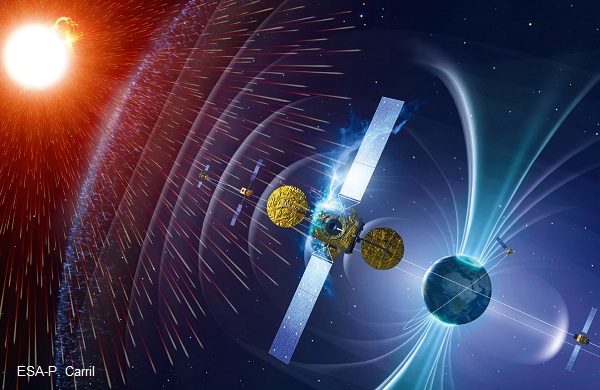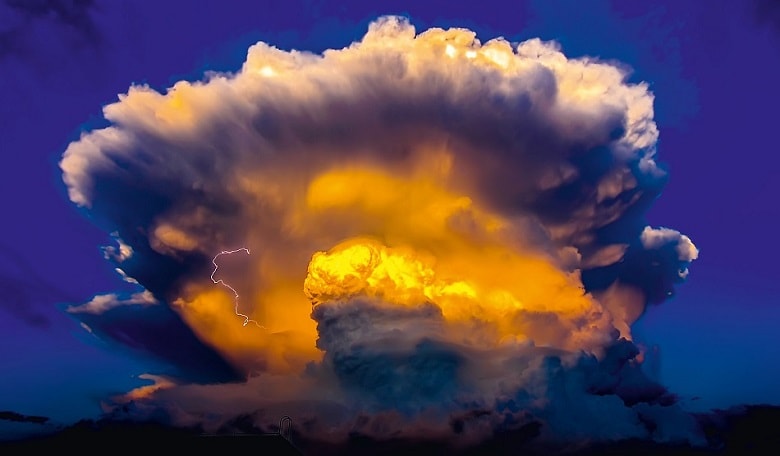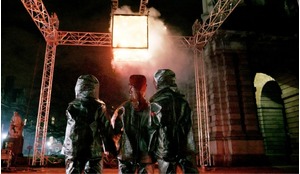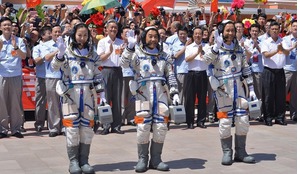The last few years have seen increasing appreciation that our life on Earth faces significant risks from space hazards and that practical action to mitigate those risks is highly desirable, and well within human capabilities. One of these risks is the impact of near-Earth objects, especially smaller objects such as the Chelyabinsk meteor of February 2013. This 12,000-ton meteor exploded in the atmosphere generating a shock wave that led to the injury of around 1500 people.
Meteor impacts of this size are expected to occur somewhere on Earth around once-per-century. So they fit well in the realm of natural hazards, alongside the 1-in-100 year flood, the 1-in-100 year storm, and so on. The assessment and mitigation of this level of risk is recognised as an important public activity in countries around the world.
But there is another hazard from space that is more insidious in its impacts on human activities, and can disrupt the whole planet, not just a particular region. This hazard is space weather.
The risk is that “storms” in the space plasma environment around the Earth can disrupt many of the advanced technologies on which human society now critically relies. Key examples of these technologies include the power grid, civil aviation and many satellite applications. The threat posed to these technologies by severe space weather has been well documented in a range of studies, most prominently in a study by the UK Royal Academy of Engineering (Cannon et al, 2013).
Risks of severe space weather
This showed that the 1-in-100 year space weather storm could seriously disrupt many of these critical technologies, leading to major disruption of societal and economic activities around the world. As a result, severe space weather is now considered a major national risk in a growing number of countries including the Netherlands, Sweden and the US. In the UK it has been included in the National Risk Register since 2012, and is subject of ongoing work, across government, academia and key industries, not only to mitigate that threat through a mixture of measures, including forecasting of space weather and hardening of vulnerable systems but also to deepen the public’s understanding of the threat.
One important challenge in deepening public understanding is to find good ways to communicate the threat from space weather. It is a more subtle risk than that from near-Earth objects – essentially giant rocks in space – because the adverse impacts of space weather are caused by intangible physical phenomena such as electromagnetic fields and particle radiation.
Space weather does not directly threaten immediate injury to human beings, rather it disrupts and damages satellites and other infrastructures on which we have come to depend, and this puts lives and livelihoods at risk. This is what makes space weather an insidious hazard; it has crept up on us, not through any change in the natural environment, but through our adoption of technologies that have done so much to improve our lives.
The adverse impacts of space weather are caused by intangible physical phenomena
Scientists and engineers now understand that these technologies are vulnerable to space weather, but also that these vulnerabilities can be fixed. The challenge is to communicate both these messages.
Public dialogue
The UK Space Weather Public Dialogue is one project within a wider programme of public dialogues organised under the ScienceWise programme in the UK. These dialogues are processes during which members of the public interact with scientists, other stakeholders (for example, research funders and businesses) and policy makers to deliberate on issues relevant to future policy decisions. The outcomes should help policy makers to gain a rich understanding of public aspirations and concerns, and thus make better, more robust decisions that reflect public values and societal implications.
A solar eruption on 16 April 16 2012 captured here by NASA’s Solar Dynamics Observatory. Such events contribute to space weather
Thus the Space Weather Public Dialogue is complementing and supporting the wider development of UK policies for mitigating the risk posed by severe space weather. The process also explored the public perception of the wider resilience of civil society, of how space weather fits into this wider picture, and of the division of responsibilities for providing resilience in civil society (not least how far members of the public think that Government and businesses should go to mitigate space weather impacts).
The core of the Dialogue process was a series of workshops that brought members of the public together with a number of space weather experts. Over the summer of 2014 we held pairs of weekend workshops at three locations across the UK: Edinburgh, representing an urban environment; Wrexham in North Wales, representing a rural environment; and Reading, representing the national environment. Around 20 members of the public from each area took part in the workshops, with care being taken to have a good balance of gender, age and local ethnicity.
At the first workshop they were introduced to the concept of space weather and its adverse impacts, and also to wider concepts of risk and resilience. Following this, participants were encouraged to discuss these topics with family and friends, and to try some home experiments such as living without electricity for a day or so.
At the second workshop, four weeks later, they were asked to provide feedback on their experiences. This then provided a context for the workshop participants to explore what severe space weather would mean for themselves and for their community, and then looking more widely, on its implications for all levels of government and for businesses. This in turn enabled discussions on what makes individuals and communities resilient to space weather (and indeed to many other risks), and on how responsibility for resilience should be split between individuals, communities, government bodies and businesses.
After the summer we held two further events to consolidate the results. The first was a seventh workshop that brought together some of the members of the public who had taken part in each of the earlier workshops, plus the usual bevy of space weather experts. This took place in September 2014 at the outreach centre of Jodrell Bank Observatory, providing a scientifically attractive place for the public participants to visit and that was centrally located between their home areas.
‘Stakeholder
The final event, in October 2014, was a “Stakeholder Summit” held at STFC’s study centre in Abingdon, Oxfordshire. This brought together representatives of all the groups involved in the Dialogue: a number of public participants from the earlier workshops, plus space weather and outreach experts from all the bodies who had funded the Dialogue, and from other organisations who had provided expert support for the Dialogue or expressed interest in its outcomes. This was a one-day event that enabled all concerned to review the draft report and to tease out important details to be addressed in the final report.
These workshops and meetings were complemented by a number of on-line activities including a project web-site (http://talkspaceweather.com), a blog and forum within the web site and a Twitter account (@spaceweatherpd). These provided support for the workshops, e.g. disseminating information on what was happening and giving the public opportunities to interact with experts. However, the public take-up of on-line opportunities was low, especially when compared to the depth of the interactions between public and experts that we saw in the workshops.
The Dialogue team also carried out two on-line surveys, one open to self-selecting participation, and one targeted on an existing, demographically-balanced survey panel. The surveys, especially the targeted survey, provided some useful information that supported what we learned from the workshops. But, as with the other on-line activities, the public response was modest. It was the face-to-face interactions at the workshops that have dominated our Dialogue.
What did we learn?
Overwhelmingly the adverse impact that catches the attention of the public is the loss of electric power. Expert concerns about impacts on civil aviation and GNSS occasionally got some attention but interest quickly returned to loss of electricity. This is no surprise – it simply highlights that electricity is the fundamental infrastructure of modern societies. Loss of supply will become a nuisance within minutes, a serious inconvenience within hours and a total disruption of everyday life within days.
The Chelyabinsk meteor was a reminder of the dangers of space
Some public participants in the paired workshops did attempt to live for a day without electricity, but generally gave up after a few hours because of the inconvenience. Some then turned the experiment on its head – instead of not using electricity, they just very carefully monitored their usage. This neatly highlighted their dependence on electricity (the real aim of the experiment) without causing inconvenience.
It is interesting to speculate on why there was limited public interest in space weather impacts on aviation and GNSS. The aviation case seems straightforward: it probably reflects the fact that many people fly only occasionally, maybe one or twice a year on holiday. Furthermore air travel is often an uncomfortable experience with queuing at airports, as well as flight delays due to normal weather, aircraft faults and air traffic control problems. Thus for the public, space weather may just be a little more inconvenience to an already difficult activity and is something they will put up with to gain the benefits of occasional air travel. This suggests that the aviation risk is of more concern to the professionals who have to deliver a safe and reliable service to the public, and thus have to solve all the problems that threaten that service.
A fragment of the Chelyabinsk meteor next to a scale cube
The limited interest in impacts on GNSS is perhaps more subtle. It may just be that direct public use of GNSS services is still limited, so their loss is not seen as a big problem. It may also be that there is a selection effect; that participants in the Dialogue may have low dependence on GNSS services. If so, the Dialogue may have missed those members of the public who would today be directly affected by space weather impacts on GNSS.
There was limited public interest in space weather impacts on aviation and GNSS
The workshops showed that it is straightforward to communicate space weather risks to the public, that this is much appreciated by the public, and that it will be a valuable contribution to society’s resilience against space weather. A key phrase that came out of the Dialogue is that “knowledge is power,” i.e. when people have awareness of space weather (indeed of any natural hazard), they are empowered to deal with the adverse impacts. They are then aware of the likely scale of the impacts, of the work being done to mitigate those impacts, and that governmental authorities are planning to deal with any ensuing crisis. This all acts to reassure people and to counter the scaremongering about natural hazards.
Personal resilience
It was clear from the workshops that the public are keen to take responsibility for personal resilience and for community resilience (i.e. neighbours working together) and that this should complement and be empowered by official resilience measures. Yet most workshop participants were unaware of the Local Resilience Forums (LRFs) that now exist to coordinate official resilience actions at the local level. They were pleased to learn of this and recommended that efforts be made to raise public awareness, e.g. occasional open meetings to build up links between LRFs and the communities that they serve.
 Space weather presents a danger to technology in space and on Earth
Space weather presents a danger to technology in space and on Earth
Ideas on personal resilience against space weather focused on generic practical measures to cope with extended power cuts, e.g. alternative lighting and cooking systems such as for camping, solar chargers for mobile devices, battery-powered radios, as well as traditional backups such as candles and wood fires. Community resilience focused more on supporting neighbours, especially those who are more vulnerable through age or other circumstances, plus the communication of news about the crisis and efforts to resolve it.
It was clear that the essential underpinning is education, both specific education on space weather and its adverse impacts, but also generic education on resilience. A number of approaches were discussed and it was clear that what is needed is a drip-feed approach where information is disseminated in small amounts at many suitable opportunities, e.g. as an aside during normal weather forecasts when there is a noteworthy solar or auroral event to provide a hook; through inclusion in school education (noting that space weather is a great way to illustrate parts of basic physics education). One very interesting point made by the public participants was that work on space weather models and forecasts is a great help in educating people about space weather.
It was also recognised that industry plays an important part in resilience against space weather, since many of the vulnerable infrastructures are operated by commercial organisations. The workshops showed strong support for systems resilience against space weather – that everyone government, industry and public should play their part, whether through hardening systems or responding to events. But there was strong support for the view that industry should pay its way in developing resilience against space weather, and should not rely on the public purse to cover costs.
The Space Weather Public Dialogue has proved to be a very useful exercise in exploring (a) public attitudes to space weather and its mitigation, (b) how to communicate the risk to the wider public, and (c) how personal and community resilience can complement official efforts. The bottom line is, unsurprisingly, the importance of maintaining the supply of electric power.
References
Cannon, Paul, et al. 2013, “Extreme space weather: impacts on engineered systems and infrastructure.” Royal Academy of Engineering, (http://tinyurl.com/oavbwux)














